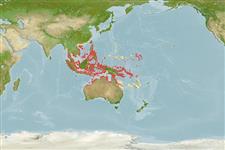>
Eupercaria/misc (Various families in series Eupercaria) >
Labridae (Wrasses) > Corinae
Etymology: Halichoeres: Greek, als, alis = salt + Greek, choiros = pig (Ref. 45335).
More on author: Bloch.
Environment: milieu / climate zone / depth range / distribution range
Ecologie
marien rifbewoner; diepte 0 - 10 m (Ref. 9710). Tropical; 19°N - 12°S
Western Central Pacific: Philippines to the Great Barrier Reef (Ref. 2334). Restricted to the Indo-Malayan region in the broad sense.
Grootte / Gewicht / Leeftijd
Maturity: Lm ? range ? - ? cm
Max length : 19.0 cm SL mannelijk / geslacht onbekend; (Ref. 9823)
Korte beschrijving
Determinatiesleutels | Morfologie | Morfometrie
Dorsale stekels (totaal) : 9; Dorsale zachte stralen (totaal) : 10 - 11; Anale stekels: 3; Anale zachte stralen: 10 - 11; Wervels: 25. Usually bright green in algae habitat, but pale or with longitudinal dark bands on plain rubble (Ref. 48636). Head of male with intricate reticulate pattern of bands that varies from one individual to another; small blackish spot on anus. Juveniles and females with dark dots dorsally and posteriorly; these are lost in males. Anterior lateral line scales with 1-3 pores; 8-13 suborbital pores. Anterior dorsal and anal soft rays longer than posterior rays; male pelvic fins not reaching the anus.
Inhabits shallow protected coral reefs and nearby silty sand and rubble bottoms (Ref. 2334). Feeds mainly on hard-shelled prey, including mollusks, crustaceans and sea urchins (Ref. 9823).
Levenscyclus en paargedrag
Maturiteit | Voortplanting | Paaien | Eieren | Fecunditeit | Larven
Distinct pairing during breeding (Ref. 205).
Randall, J.E., G.R. Allen and R.C. Steene, 1990. Fishes of the Great Barrier Reef and Coral Sea. University of Hawaii Press, Honolulu, Hawaii. 506 p. (Ref. 2334)
Status op de Rode Lijst van het IUCN (Ref. 130435: Version 2024-1)
Gevaar voor de mens
Harmless
Gebruik door de mens
Visserij: van minder commercieel belang; Aquarium: Commercieel
Tools
Speciale rapporten
Download XML
Internetbronnen
Estimates based on models
Preferred temperature (Ref.
123201): 28 - 29.3, mean 28.8 °C (based on 1830 cells).
Fylogenetische diversiteitsindex (Ref.
82804): PD
50 = 0.5000 [Uniqueness, from 0.5 = low to 2.0 = high].
Bayesian length-weight: a=0.00741 (0.00426 - 0.01291), b=3.02 (2.87 - 3.17), in cm total length, based on LWR estimates for this species & Genus-body shape (Ref.
93245).
Trofisch niveau (Ref.
69278): 3.4 ±0.40 se; based on food items.
Weerstandsvermogen (Ref.
120179): Gemiddeld, minimale populatieverdubbelingstijd 1,4-4,4 jaar (Preliminary K or Fecundity.).
Fishing Vulnerability (Ref.
59153): Low vulnerability (13 of 100).
Nutrients (Ref.
124155): Calcium = 77 [45, 131] mg/100g; Iron = 0.659 [0.374, 1.246] mg/100g; Protein = 18.5 [15.7, 20.7] %; Omega3 = 0.132 [0.082, 0.207] g/100g; Selenium = 18.9 [11.0, 35.0] μg/100g; VitaminA = 148 [44, 557] μg/100g; Zinc = 1.7 [1.2, 2.7] mg/100g (wet weight);
